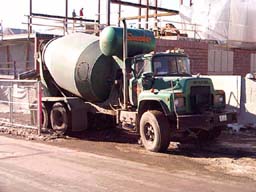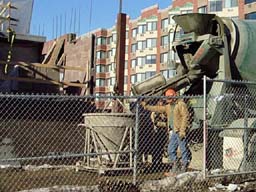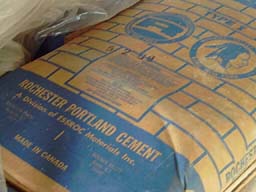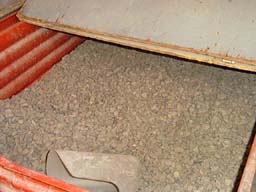|
|
What is concrete?
|
Concrete is not found in nature the way we would find aluminium,
nickel or iron. Concrete is formed from combining water, a special cement and rock:
PORTLAND CEMENT + H2O + ROCK = HARDENED CONCRETE + ENERGY(HEAT)
Heat? Yes, and lots of it if your concrete structure is big. The heat, and
temperature variations in general, can cause
cracking problems.
|
 |
 |
A common mistake people make is to use the words cement and concrete interchangably.
It is important to remember that cement is only a component of concrete and
concrete is the structural material. The cement used in concrete is not used
as a building material because it would be too expensive and not as strong as
concrete. So when you see a parking garage, a driveway, a sidewalk or a road
remember it is made of concrete, not cement. And, by the way, that funny looking
truck is a concrete mixer, not a cement mixer! But, if cement is not concrete,
then what is it?
|
Cement is a general name for a material that binds other materials together.
Yes, it is another name for glue. There are many materials which we would
classify as cements and they are usually identified with certain uses, and
can produce different types of "concrete". The type of cement used to make
the riding surface of some of our roads (blacktop!) is called asphalt cement.
It is a petroleum bi-product, and it binds rock into the road material we call
asphaltic concrete.
|
|
The structural concrete used in bridges and dams and other
types of road surfaces is made from Portland
cement (#). This cement binds the rock (also called aggregate) together
to form concrete. Portland cement is a mixture of processed limestone, shales,
and clays which contain the following compounds: CaO (lime),
Al2O3 (Alumina),SiO2 (silica) and iron
oxides. Properties of the cement will vary depending on the relative
amounts of these compounds. |
 |
Adding water to the dry cement starts a chemical reaction
(hydration). While the mixture of cement, water, and rock is fluid, it can be
poured into molds (called formwork) of arbitrary shape. This is a valuable
property of concrete which allows us to build dams with the many different
shapes which you saw in the history of dams.
The compound gradually hardens into the desired final shape.
The water/cement ratio (w/c) of the mixture has the most control over
the final properties of the concrete.
The water/cement ratio is the relative weight of the water to the cement
in the mixture. The water/cement ratio is a design criterion for the engineer.
Selection of a w/c ratio gives the engineer control over two opposing, yet
desirable properties: strength and workability. A mixture with a high w/c will
be more workable than a mixture with a low w/c: it will flow easier. But the
less workable the mixture, the stronger the concrete will be. The engineer
must decide what ratio will give the best result for the given situation.
This is not an entirely free choice because the water/cement ratio needs to be
about 0.25 to complete the hydration reaction.
Typical values of w/c are between 0.35 and 0.40 because they give a good amount
of workability without sacrificing a lot of strength.
|
 |
The other important component for strength is the aggregate, the rock that is being bound
by the hardened cement. Aggregate is what makes the difference
between hardened cement and the structual material, concrete. Aggregate
increases the strength of concrete and is a fundamental economical factor because it
takes up a large volume of the concrete and is much less expensive than an equivlant volume
of cement. To make very strong concrete requires a low w/c and strong
aggregate. There might be thousands or millions of tons of cement and
aggregate in a large dam. Finding the aggregate for the dam, and
transporting it and the cement to the dam site are important societal factors.
|
|
Typical Composition by Volume
|
|
Cement
|
7-15%
|
|
Water
|
14-21%
|
|
Aggregate
|
60-80%
|
|
|
Here's a chance to make your own concrete.
Notice that each component does not have a specific value, but rather
a range of acceptable values. This means there are many ways to make concrete.
Which combination of componants gives the strongest concrete? If an engineer
designs a dam assuming a certain strength concrete, how does she/he know that the
concrete used was the strength wanted? These questions and more are answered by testing.
But before we can break it, we need to make it, so read the recipe, get down to your local
building supply store, and engineer some concrete!
What can we learn about concrete
from testing?
|


|




